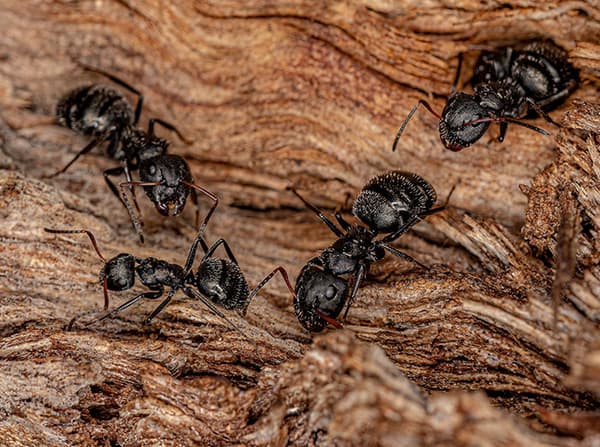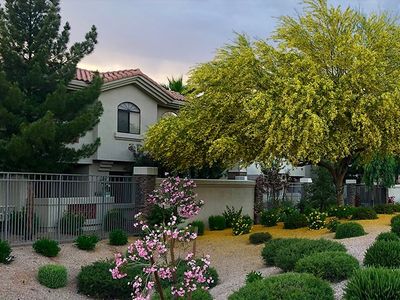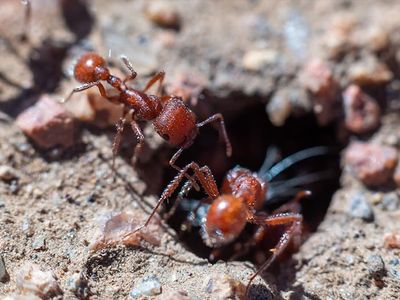What do carpenter ants look like?
There are more than 60 carpenter ant species in the United States that vary slightly in appearance. All of them are large, having workers ranging from ¼ to ⅚ of an inch in length, and queens twice that size. The two most common colorations are a black head and abdomen with a dark red thorax, or ants that are entirely black. While carpenter ants are big, they have major and minor workers, and the minor workers are sometimes mistaken for ants of other species.

- Carpenter ants can lift up to seven times their own weight with their teeth!
- Carpenter ants chew through wood but don't eat it.
- Carpenter ants are very neat and clean.
Get Free QuoteCall Today (480) 646-4303
Are carpenter ants destructive?
The workers of a carpenter ant colony target soft and decaying wood. If your home has no wood rot, you may not have trouble with these ants. But, when these ants find decaying wood and tunnel into it, they can spread to wood that is not rotten. They can also get into homes through cracks and find interior wood inside floors and walls that are compromised by water. For example, damaged grout in a shower can let water run into a crack and soak the subflooring beneath the shower, leading to wood root and pest problems. It takes years for carpenter ants to cause significant damage, but they are sneaky insects and more than capable.
Do carpenter ants bite?
The word bite is often used to describe the wounds caused by ants. But most ants don't bite, they sting. This is not the case with the carpenter ant. When defending its nest, it can use the same jaws it uses to gnaw through wood to bite human skin. It doesn't hurt when these ants bite you, their bites may just break the skin, but they are not venomous and do not spread disease or illness.
Are carpenter ants the same as termites?
Yes and no. In many ways, they are the same. They're both insects with six legs, three body parts, and two antennae. They both attack homes that have water damage or wood rot and they both have the ability to damage wood. But termites and carpenter ants damage wood in different ways. Carpenter ants carve galleries to create nests. Termites consume wood, eating the soft portions first. Of the two, termites are a more significant threat to homes and structures in the Phoenix metro.
What attracts carpenter ants?
If you've read this far, you may think that decaying wood is what attracts carpenter ants, but it isn't. Soft, rotted wood provides a location to establish a nest, but carpenter ants can establish their nests in many places besides inside your home, and they're not going to spend much time thinking about it until they've found what they are looking for on your property.
Carpenter ants are attracted to food sources. Most are attracted to sweet sources, such as nectar and honeydew. They also consume insects, both alive and dead.
How do I get rid of carpenter ants?
Due to the sneaky nature of these insects and their destructive potential, we strongly recommend a professional carpenter ant treatment. Contact a licensed pest management professional for systematic detection, elimination, and surveillance. For assistance in Arizona, see if you're in our service area. The Greenway Pest Solutions team can help you address these ants properly.
Can carpenter ants be prevented?
There are many ways you can prevent a carpenter ant problem. The goal is to remove the things that attract them and block the routes they may use to enter your home. Here are some tips that will guide you in the right direction:
- Address aphids, white flies, and scale insects. These plant pests produce honeydew which is the greatest attractant for carpenter ants.
- Address weeds in your yard, as flowering plants provide nectar for these ants.
- Reduce insects by keeping lights off where it is not a security concern.
- Address moisture to reduce the potential for wood rot, and also reduce the number of insects that are attracted to moisture, as carpenter ants eat them.
- Use a caulking gun to seal structural gaps or fill in holes and crevices.
- Address damaged weatherproofing.
- Remove wood debris next to your home and store wood sources in bins to get the materials off the soil.
Every property is slightly different. Use these tips to zero in on carpenter ant attractants on your property. For help evaluating conducive conditions, reach out to your Greenway Pest Solutions team for assistance in the Phoenix metro.








